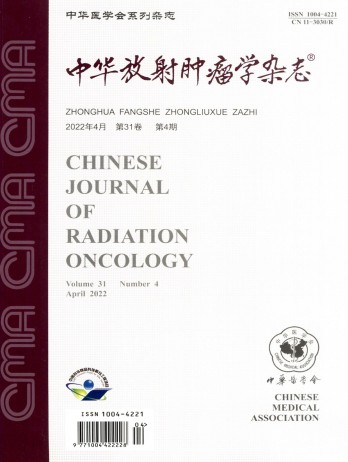Dosimetric effect of set-up errors on nasal NK/T cell lymphoma based on dose reconstruction
引用次数: 0
Abstract
Objective To evaluate the dosimetric effects of set-up errors on nasal NK/T cell lymphoma by introducing set-up errors into the radiotherapy planning system for dose reconstruction. Methods Ten patients with nasal NK/T cell lymphoma were recruited. A non-coplanar volumetric modulated arc therapy plan was designed for CT image and clinical target area of each patient. After the completion of the plan, the set-up errors were introduced into the radiotherapy plan by changing the ISO of the treatment, and dose calculation was performed to reconstruct the dose distribution. Results With the increase of system set-up errors, the dose of target was decreased and the order affected by set-up errors in different directions was: left-right direction> head-foot direction> front-rear direction. When the translational set-up errors in each direction were -3 mm to 3 mm and the rotating set-up errors were -3° to 3°, the range of dose change in all targets was less than ±3%. When the set-up errors in all directions were ≤ 3 mm, the dose of organ at risk was less than or similar to the prescribed dose. When the set-up errors were> 3 mm, the doses of lens, spinal cord, parotid gland and optic nerve gradually exceeded the prescribed dose. Only when the rotating set-up errors were ≥ 3°, the dose of lens exceeded the prescribed dose. Special attention should be paid to the influence of the greater set-up errors in the left and right direction on lens, spinal cord and parotid gland, as well as on the spinal cord due to the larger set-up errors in the front and rear direction. After the actual set-up errors were introduced from our department, it exerted slight effect on the irradiation dose of GTV and CTV, which was less than ±2%. In a few cases, the dose of organ at risk potentially exceeded the prescribed dose limit, and special attention should be diverted to overdose of the lens and optic nerve. Conclusions The set-up errors will result in target dose deficiency and overdose of organ at risk in nasal NK/T cell lymphoma, especially upon the set-up errors in the left and right direction. The effect of 3 mm and 3° set-up errors on target and organ at risk is limited. Therefore, it is recommended to maintain the single direction set-up errors within 3 mm and 3°. The actual set-up errors introduced from our department exert little effect on the target dose, but a small number of organs are at risk of exceeding the prescribed dose limit. It is necessary to increase the evaluation of the extension region of organ at risk. Key words: Nasal natural killer/T-cell lymphoma; Set-up error; Dosimetry基于剂量重建的设置误差对鼻腔NK/T细胞淋巴瘤的剂量学影响
目的通过在放疗计划系统中引入设置误差进行剂量重建,评价设置误差对鼻腔NK/T细胞淋巴瘤的剂量学效应。方法选取10例鼻腔NK/T细胞淋巴瘤患者。针对每位患者的CT图像和临床靶区设计非共面体积调制弧线治疗方案。计划完成后,通过改变治疗的ISO,将设置误差引入放疗计划,进行剂量计算,重建剂量分布。结果随着系统设置误差的增大,靶药剂量逐渐减小,不同方向设置误差对靶药剂量的影响顺序为:左右方向>头足方向>前后方向。当各方向平移设置误差为-3 mm ~ 3mm,旋转设置误差为-3°~ 3°时,各靶点的剂量变化幅度均小于±3%。当各方向设置误差≤3mm时,危险器官的剂量小于或接近规定剂量。当设置误差为bb0 ~ 3mm时,晶状体、脊髓、腮腺和视神经的剂量逐渐超过规定剂量。只有旋转设置误差≥3°时,镜片剂量才会超过规定剂量。特别要注意左右方向设置误差较大对晶状体、脊髓和腮腺的影响,以及前后方向设置误差较大对脊髓的影响。经我科介绍实际设置误差后,对GTV和CTV的辐照剂量影响不大,均在±2%以内。在少数情况下,危险器官的剂量可能超过规定的剂量限制,应特别注意晶状体和视神经的过量。结论鼻腔NK/T细胞淋巴瘤的靶剂量设置错误会导致靶剂量不足和危及器官过量,尤其是左右方向设置错误。3毫米和3°的设置误差对靶和器官的影响是有限的。因此,建议将单方向设置误差保持在3mm和3°以内。从我科引进的实际设置误差对目标剂量影响不大,但少数器官有超过规定剂量限值的危险。有必要增加对危险器官延伸区域的评估。关键词:鼻腔自然杀伤/ t细胞淋巴瘤;设置错误;剂量测定法
本文章由计算机程序翻译,如有差异,请以英文原文为准。
求助全文
约1分钟内获得全文
求助全文
来源期刊
自引率
0.00%
发文量
6375
期刊介绍:
The Chinese Journal of Radiation Oncology is a national academic journal sponsored by the Chinese Medical Association. It was founded in 1992 and the title was written by Chen Minzhang, the former Minister of Health. Its predecessor was the Chinese Journal of Radiation Oncology, which was founded in 1987. The journal is an authoritative journal in the field of radiation oncology in my country. It focuses on clinical tumor radiotherapy, tumor radiation physics, tumor radiation biology, and thermal therapy. Its main readers are middle and senior clinical doctors and scientific researchers. It is now a monthly journal with a large 16-page format and 80 pages of text. For many years, it has adhered to the principle of combining theory with practice and combining improvement with popularization. It now has columns such as monographs, head and neck tumors (monographs), chest tumors (monographs), abdominal tumors (monographs), physics, technology, biology (monographs), reviews, and investigations and research.

 求助内容:
求助内容: 应助结果提醒方式:
应助结果提醒方式:


